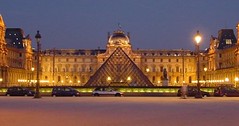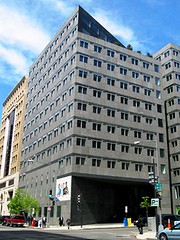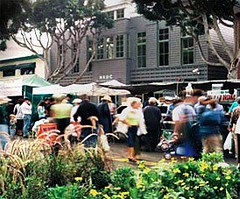When a "green building" really is: it's the location, stupid

Posted October 26, 2007 at 10:03PM
 In my previous entry, I name-dropped the great modernist architect I.M. Pei. Most architecture buffs and probably quite a few readers know that his firm, Pei Cobb & Freed, designed many striking buildings that are regarded as icons of our contemporary built environment: the Louvre pyramid in Paris, the East Wing of the National Gallery of Art in Washington, the Hancock Tower in Chicago, and the Rock and Roll Hall of Fame in Cleveland, just to name a few.
In my previous entry, I name-dropped the great modernist architect I.M. Pei. Most architecture buffs and probably quite a few readers know that his firm, Pei Cobb & Freed, designed many striking buildings that are regarded as icons of our contemporary built environment: the Louvre pyramid in Paris, the East Wing of the National Gallery of Art in Washington, the Hancock Tower in Chicago, and the Rock and Roll Hall of Fame in Cleveland, just to name a few.
But what I suspect even most of my NRDC colleagues don’t know is that Pei Cobb also designed one of Washington, DC’s first modern green buildings, and that it is the very building that houses our DC office. In fact, as I type, I am sitting in my office on the fifth floor of that building, owned by the American Academy for the Advancement of Science. Go to NRDC’s web site and you will learn about the building’s substantial energy-saving features, which cut energy use by 50 percent compared to a conventional building and were quite advanced for when the building opened in 1996.
 It’s also a great building to inhabit. Personally, I am especially fond of the choices that Pei Cobb made to bring natural light into the interior, house an art gallery in the lobby, and create an airy staff lounge (that all building tenants can use) on the top floor. Follow the next link on our web site and you can also learn about all the additional things that NRDC did to its suite, incorporating resource-conserving and pollution-reducing materials in our walls, fixtures, and carpets, along with operational systems that further reduce energy use. These are all great things.
It’s also a great building to inhabit. Personally, I am especially fond of the choices that Pei Cobb made to bring natural light into the interior, house an art gallery in the lobby, and create an airy staff lounge (that all building tenants can use) on the top floor. Follow the next link on our web site and you can also learn about all the additional things that NRDC did to its suite, incorporating resource-conserving and pollution-reducing materials in our walls, fixtures, and carpets, along with operational systems that further reduce energy use. These are all great things.
But what you won’t find on our site is actually by far the building’s greenest feature: its downtown location. A recent report in Environmental Building News demonstrates that the amount of energy used (and greenhouse gases emitted) by a typical building’s operation is dwarfed by the amount that employees and visitors typically consume getting there and back. This is due in no small part to the fact that most new office buildings are built on completely car-dependent sites on the fringe of our metro areas. The data show that a “green” building simply isn’t what it claims to be unless it is in a location that saves transportation energy as well as building energy. This generally means that it is relatively central, in a walkable neighborhood with nearby offices, homes, shops and services and, if in a metro area of any size, well-served by public transit.
These things allow people to live and work more conveniently, use alternative forms of transportation, and drive shorter distances, all of which save time and energy. Research also shows that a central location, in particular, is the single most important factor in determining how much transportation energy (and staff time) can be saved, and that the savings are compounded when nearby shops, services, homes, safe walking routes, and transit are added to the equation. In fact, a study by NRDC trustee Jonathan Rose shows that a home in an urban location will save more energy than one located in an outlying area, even if the suburban house has advanced green building features and the occupants drive hybrid cars.
 All of NRDC’s principal offices have these requisites in abundance. Our state-of-the-art Redford Center, for example, is located in downtown Santa Monica, probably the most walkable neighborhood in southern California. Here in Washington, we are only a block away from three Metro subway lines, a block from the DC Circulator bus, and four blocks from two additional Metro lines. In addition, our staff in many cases can walk from home to work, and from work to the Environmental Protection Agency, the Justice Department, and to other agencies, law firms and organizations with which we do business. If it’s too far, it’s seldom more than a Metro stop or two away. We also can and do enjoy a wide variety of nearby restaurants, retail establishments, and amenities like gyms and parks. By getting to these conveniences on foot, our staff members save time as well as a large number of what in another setting might be after-work automobile trips. Life is good.
All of NRDC’s principal offices have these requisites in abundance. Our state-of-the-art Redford Center, for example, is located in downtown Santa Monica, probably the most walkable neighborhood in southern California. Here in Washington, we are only a block away from three Metro subway lines, a block from the DC Circulator bus, and four blocks from two additional Metro lines. In addition, our staff in many cases can walk from home to work, and from work to the Environmental Protection Agency, the Justice Department, and to other agencies, law firms and organizations with which we do business. If it’s too far, it’s seldom more than a Metro stop or two away. We also can and do enjoy a wide variety of nearby restaurants, retail establishments, and amenities like gyms and parks. By getting to these conveniences on foot, our staff members save time as well as a large number of what in another setting might be after-work automobile trips. Life is good.
To date, the US Green Building Council’s “LEED” rating system for green buildings has done a poor job of recognizing the importance of location to the environment. But that is changing, thanks to NRDC’s partnership with the Council and with the Congress for the New Urbanism in creating the new LEED for Neighborhood Development, a rating system that stresses location and neighborhood characteristics. I’ll report on that in a future entry. Now go take a walk.